Total War: Warhammer 2's campaign is trying something different
"The fourth race hasn't been ratified yet."
Last week I played a couple of battles in Total War: Warhammer 2, leading an army of Lizardmen to victory against a pair of High Elf mages that'd been meddling (surprise, surprise) with magical ruins beyond their comprehension. I had a great time with it and we'll be able to share that gameplay footage in a couple of weeks.
But for now, I thought it'd be useful to break down everything else we learnt during the visit to developer, Creative Assembly. While it was fun to control an entirely new race in these battles, aside from the unit roster it was a fairly similar experience to that of the previous game. It's actually on the campaign map that things seem really fresh.
Oh and, yeah, I did try to get confirmation regarding the game's fourth race that is very obviously the Skaven. Here's what they gave me:
"The fourth race hasn't been ratified yet," said communications manager Al Bickham. Ratified. He actually said ratified. I don't know what I'm even doing anymore. I quit.
Let's talk about the end-game
Although you can win the campaign in standard Total War fashion through conquest of the other races on the map, Warhammer 2 has an alternative objective that you'll want to be thinking about.
"This is our interesting experiment," explains Bickham. "To build a crashing crescendo to the end-game, rather than owning half the map, painting it your colour and knowing that nobody can beat you."
Each of the four races has ambitions to either stabilise or corrupt a big magical whirlpool called the Great Vortex, requiring them to complete a series of rituals across the various continents of the New World.
The AI-controlled races will be pursuing this goal too, just like the player, meaning that it's entirely possible to lose the campaign even if you have the largest armies in the game. It's going to be really important to keep an eye on how your neighbours are getting on with the Vortex each turn and we're told the UI will make it very clear who's currently in the lead.
There's also meant to be some kind of big finale planned as one of the races approaches victory. You'll know it when the Vortex is being tampered with, we're told. I imagine there'll be a relatively large battle involved. Just a guess.
"The end-game is the really big thing," said game director, Ian Roxburgh. "It changes the whole atmosphere of playing through the campaign."
Legendary lords and starting positions
In the first Total War: Warhammer, selecting a legendary lord is simply a case of deciding which hero you want to begin your campaign with. Other than the unit leading your first army and the abilities they can unlock, not a lot really changes.
In Warhammer 2, this isn't the case. Each race offers two legendary lords for you to choose between and they have entirely different starting locations. If you're playing as the High Elves, for example, you can go for Prince Tyrion and start your campaign with a city in Ulthuan surrounded by other High Elf factions, or instead select his brother Teclis and find yourself on an entirely different continent. Those two campaigns will inevitably play very differently, as your initial goals, enemies and allies change as a result.
"That means, effectively, we've got four new playable races but we've got eight unique factions," said Roxburgh.
Interestingly, the legendary lord that you choose not to control will still exist on the campaign map, leading an entirely separate faction. If you want to recruit them, it'll require some shrewd diplomacy and an eventual confederation.
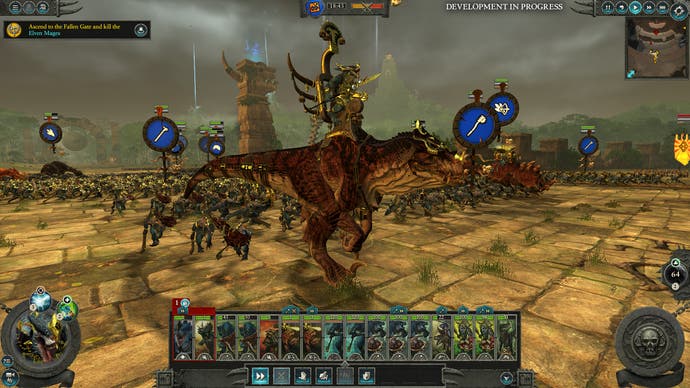
Old World races
Alongside the High Elves, Dark Elves, Lizardmen and yet-to-be-ratified races, you'll also find the Old World races from Warhammer 1 have a presence in the New World. These factions won't be seeking to control the Great Vortex, but you'll be able to interact with them, through conflict or diplomacy, as you would any other race.
We're told there are plenty of examples of this happening in the lore itself, with Old World races like the Empire sending expeditionary forces into the New World. Creative Assembly hasn't needed to take too many liberties when it comes to the Warhammer fiction, said Roxburugh.
Rogue armies
Okay, this is really exciting! The campaign map of Warhammer 2 will feature armies made up of units from different races, which you'll need to deal with before they become a threat to your settlements. We've never seen this before.
"It's an interesting campaign mechanic," said Roxburgh. "But it also generates lots of cool battles that you'd never usually see."
These armies are also meant to make sense from a lore perspective, we're told. Roxburgh described an example he liked of a goblin beastmaster that had collected creatures from each of the different races and brought them under his control. Elsewhere, there are mercenary bands and rebel forces that have offered inspiration.
Regardless, it sounds like this will provide some really unique battle setups. I asked if we'll see something similar in the Custom Battles themselves.
"We'll look into that!" promised Roxburgh.
High Elves
Just as we saw in its prequel, the various races of Warhammer 2 are looking to offer very different playstyles both in battle and on the campaign map.
The High Elves have a couple of tricks up their overly-flamboyant sleeves, particularly when it comes to foreign politics. As a general rule, once they begin trading with another faction, they gain line of sight of everything under its control. This is information that's only usually shared between allies.
They also have a unique currency to think about called influence. This is generated by agents on the campaign map or by solving political dilemmas that crop up from time to time. It can then be spent to alter the relationships between different factions from afar. Are the Dark Elves and the Lizardmen getting a bit too cosy? You can do something about that.
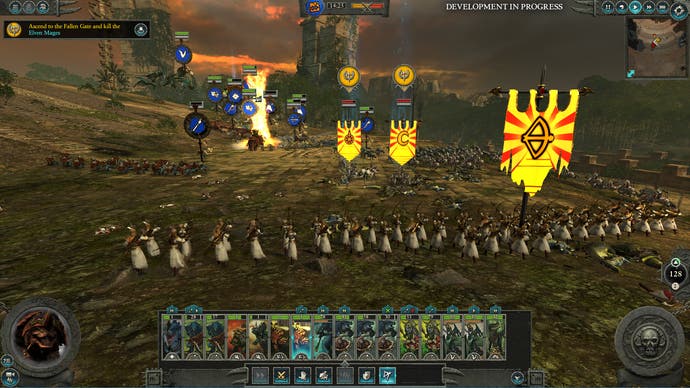
Lizardmen
We saw a little less of the Lizardmen than the High Elves on the campaign map (and nothing of the Dark Elves, sorry!), but we do know the two legendary lords: Lord Mazdamundi and Kroq-Gar.
Those familiar with the fiction of Warhammer Fantasy will have heard about the Geomantic Web, an impressive matrix of natural energy spreading across the New World and beyond. The Lizardmen's temple cities are each built on specific places of power within this web.
Controlling these temple cities in Warhammer 2 provides significant bonuses for the Lizardmen, especially if they connect directly
"If and when you own that capital and you upgrade the building chain for that building," explains Roxburgh. "You strengthen your ties with the other cities. If two built-up cities are linked together, they'll both operate at a higher level."
This is reflected through the use of commandments that are unlocked as more and more cities are linked together. Unlike the commandments offered by other races (small increases to growth, income etc.), these are meant to feel much more impactful.
Capturing settlements
A small thing perhaps, but worth knowing if you didn't like how this worked in the previous game. In Warhammer 2 every race can claim every city on the map. That being said, some cities make more sense than others depending on the needs of the race in question.
There are some disadvantages to growth and public order to consider if you capture cities that are deemed inappropriate, but yes, you can absolutely paint the map your colour if you choose to.
The Grand(er) Campaign
One of the most exciting features of Warhammer 2 is the way in which it plans to bring together the campaign maps of both games in a separate mode.
I did ask Creative Assembly if they've settled on a name for this campaign type yet, although it seems they're still working on that.
"Mega campaign? Combined campaign? We're still figuring that out," said Bickham.
"I'll be honest with you," continued Roxburgh. "I don't spend any of my time worrying about what we call it, I worry about how it works."
We're still not exactly sure how this campaign will work, but we know it puts sandbox gameplay above anything else. As a result, features like the Great Vortex victory conditions won't translate to this version of the game.
Creative Assembly anticipate this will eventually be seen as the de facto way of playing Total War: Warhammer.
We'll have more to share on the battles themselves towards the end of E3, with gameplay from one of Warhammer 2's quest battles. I don't want to brag, but it's a pretty tough encoutner and I do pull out a rather impressive Phyrric Victory in the end. And yes, I imagine we'll be hearing more from Creative Assembly about both the Dark Elves and the Skaven(?) before too long.
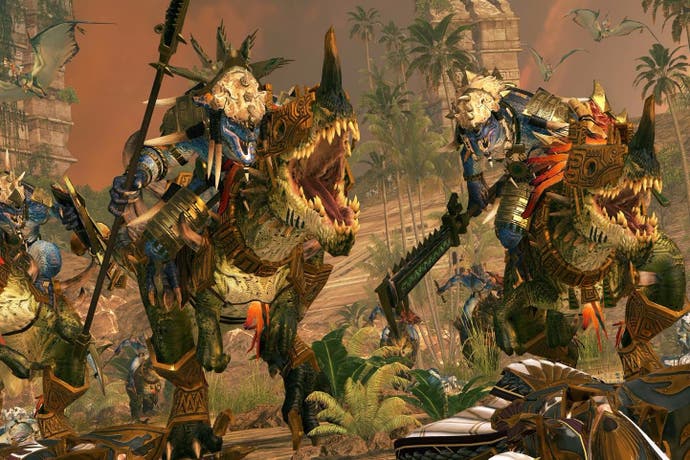



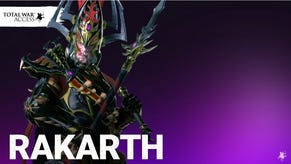
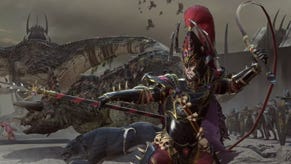


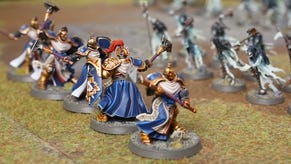
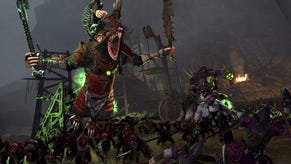


.png?width=291&height=164&fit=crop&quality=80&format=jpg&auto=webp)




.jpg?width=291&height=164&fit=crop&quality=80&format=jpg&auto=webp)
